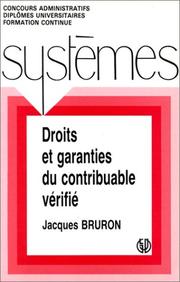| Listing 1 - 10 of 181 | << page >> |
Sort by
|

ISBN: 2275006567 9782275006567 Year: 1991 Publisher: Paris : LGDJ (Librairie Générale de Droit et de Jurisprudence),
Abstract | Keywords | Export | Availability | Bookmark
 Loading...
Loading...Choose an application
- Reference Manager
- EndNote
- RefWorks (Direct export to RefWorks)
Book
Year: 1926 Publisher: [Washington, D.C.] : [U.S. Government Printing Office],
Abstract | Keywords | Export | Availability | Bookmark
 Loading...
Loading...Choose an application
- Reference Manager
- EndNote
- RefWorks (Direct export to RefWorks)
Book
ISBN: 0844733288 Year: 1978 Publisher: Washington AEI for public policy research
Abstract | Keywords | Export | Availability | Bookmark
 Loading...
Loading...Choose an application
- Reference Manager
- EndNote
- RefWorks (Direct export to RefWorks)
Book
Abstract | Keywords | Export | Availability | Bookmark
 Loading...
Loading...Choose an application
- Reference Manager
- EndNote
- RefWorks (Direct export to RefWorks)
January 2001 - Liberalization of the natural gas industry is complex because the sector combines activities with natural monopoly characteristics with activities that are potentially competitive. The challenges are compounded when the State opts to retain vertically integrated monopolies in otherwise contestable segments of the industry. Regulatory issues associated with partial liberalization of natural gas markets are analyzed through a case study of Mexico. The natural gas industry combines activities with natural monopoly characteristics with those that are potentially competitive. Pipeline transport and distribution, which have natural monopoly characteristics, require regulation of price and nonprice behavior. Production is a contestable activity, but in a few countries (including Mexico) it remains a state monopoly. Gas marketing is also contestable, but the presence of a dominant, upstream, vertically integrated incumbent may pose significant barriers to entry. Market architecture decisions-such as horizontal structure, regional development, and the degree of vertical integration-are also crucial. Rosellón and Halpern report that Mexico has undertaken structural reform in the energy sector more slowly than many other countries, but it has introduced changes to attract private investment in natural gas transport and distribution. These changes were a response to the rapid growth in demand for natural gas (about 10 percent a year) in Mexico, which was in turn a response to economic development and the enforcement of environmental regulations. The new regulatory framework provides incentives for firms to invest and operate efficiently and to bear much of the risk associated with new projects. It also protects captive consumers and improves general economic welfare. The continued vertical integration of the state-owned company Pemex and its statutory monopoly in domestic production posed a challenge to regulators. Their response in liberalizing trade, setting first-hand sales prices, and regulating natural gas distribution makes the Mexican case an interesting example of regulatory design. As the first phase of investment mobilization and competition for the market in Mexican distribution projects concludes, remaining challenges include consistently and transparently enforcing regulations, coordinating tasks among government agencies, and ensuring expansion of gas transport services and domestic production. A key challenge in the near term will be fostering competition in the market. In strengthening the role of market forces, one issue is Pemex's discretionary discounts on domestic gas and access to transport services, made possible by its monopoly in domestic production and marketing activities and its overwhelming dominance in transport. The main instrument available to the regulator is proscribing Pemex contract pricing, but more durable and tractable instruments should be considered. This paper-a product of the Finance, Private Sector, and Infrastructure Sector Unit, Latin America and the Caribbean Region-is part of a larger effort in the region to evaluate and disseminate lessons of experience in designing policies to improve the quality and sustainability of infrastructure services. The authors may be contacted at jrosellon@dis1.cide.mx or jhalpern@worldbank.org.
Book
Year: 1926 Publisher: [Washington, D.C.] : [U.S. Government Printing Office],
Abstract | Keywords | Export | Availability | Bookmark
 Loading...
Loading...Choose an application
- Reference Manager
- EndNote
- RefWorks (Direct export to RefWorks)
Book
ISBN: 9201140029 Year: 2002 Publisher: Wien International Atomic Energy Agency
Abstract | Keywords | Export | Availability | Bookmark
 Loading...
Loading...Choose an application
- Reference Manager
- EndNote
- RefWorks (Direct export to RefWorks)
Book
Year: 1960 Publisher: Washington, District of Columbia : United States Government Printing Office,
Abstract | Keywords | Export | Availability | Bookmark
 Loading...
Loading...Choose an application
- Reference Manager
- EndNote
- RefWorks (Direct export to RefWorks)
Book
ISBN: 162808104X 9781628081046 1628081031 9781628081039 Year: 2013 Publisher: Hauppauge Nova Science Publishers, Inc.
Abstract | Keywords | Export | Availability | Bookmark
 Loading...
Loading...Choose an application
- Reference Manager
- EndNote
- RefWorks (Direct export to RefWorks)
Book
Year: 1960 Publisher: Washington, District of Columbia : United States Government Printing Office,
Abstract | Keywords | Export | Availability | Bookmark
 Loading...
Loading...Choose an application
- Reference Manager
- EndNote
- RefWorks (Direct export to RefWorks)

ISBN: 9026831536 Year: 1997 Publisher: Deventer Kluwer
Abstract | Keywords | Export | Availability | Bookmark
 Loading...
Loading...Choose an application
- Reference Manager
- EndNote
- RefWorks (Direct export to RefWorks)
| Listing 1 - 10 of 181 | << page >> |
Sort by
|

 Search
Search Feedback
Feedback About UniCat
About UniCat  Help
Help News
News